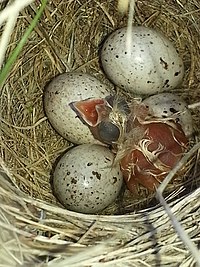Yellow-throated spur hammer
| Yellow-throated spur hammer | ||||||||||||
|---|---|---|---|---|---|---|---|---|---|---|---|---|

Male yellow-throated spurhammer |
||||||||||||
| Systematics | ||||||||||||
|
||||||||||||
| Scientific name | ||||||||||||
| Calcarius ornatus | ||||||||||||
| ( Townsend , 1837) |
The yellow-throated spur bunting ( Calcarius ornatus ), also called ornamental bunting , is a 15 centimeter large bird species from the family of the spur bunting and snow bunting .
Appearance
The male yellow-throated spur-bunting has a black breast, the lower part of the belly is white. The forehead is black on top and the rest of the head is white. Noticeable are two thin, elongated, black stripes at the height and just below the eyes. The tail is black in the middle and white on the sides. The rest of the plumage is brownish black and resembles that of the house sparrow . The female is externally colored similar to the house sparrow. Due to their good camouflage, they are difficult for predators to make out on the ground.
Distribution and way of life
This species is found in the prairie areas of the United States and Canada . It prefers slightly elevated, open terrain with dry grass growth, but also occurs in areas used by humans, e.g. B. golf courses . They feed mainly on grass seeds. The males claim a territory between 2,500 and 5,000 m². If they are startled by enemies, they usually only fly up a short distance and return in circular trajectories to the vicinity of the starting point.
Courtship
When the male advertises the females, the male usually sits down in an open, conspicuous place and draws the females' attention to himself with his song. If the male is successful and a female conspecific approaches, a chase flight occurs and both partners return to the ground in circling trajectories with slow flapping of their wings. The male lets his singing sound.
Reproduction
Yellow-throated spur chambers are ground breeders. The female lays 2–7 white, light brown or light blue eggs with brown, red or black spots in a cup-shaped nest made of blades of grass. The female takes on the breeding business on her own; the male only supports her when feeding the young. The breeding period is 10–14 days, after which the young remain in the nest for up to 2 weeks.
Hazards and protective measures
Due to its limited distribution and a massive population decline (85% between 1970 and 2014), the IUCN classifies this species as globally endangered ( Vulnerable ). The main threats to this species are the transformation of their habitat into agricultural land and climate change . Scientific studies are ongoing to protect the species and the species is listed as Endangered in Canada.
literature
- Goetz Rheinwald (ed.), Cyril Walker: Atlas of the bird world. Unipart, Remseck near Stuttgart 1994, ISBN 978-3-8122-3399-6 , p. 54.
- Christopher M. Perrins (Ed.): The FSVO encyclopedia birds of the world. Translated from the English by Einhard Bezzel. BLV, Munich / Vienna / Zurich 2004, ISBN 978-3-405-16682-3 , p. 620 (title of the original English edition: The New Encyclopedia Of Birds. Oxford University Press, Oxford 2003).
Web links
- Calcarius ornatus inthe IUCN Red List of Threatened Species 2018.1. Listed by: BirdLife International, 2017. Retrieved August 14, 2018.

